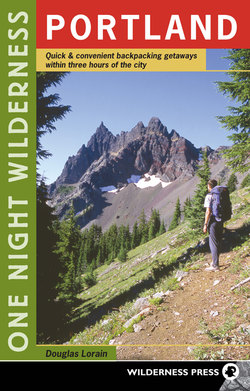Читать книгу One Night Wilderness: Portland - Douglas Lorain - Страница 14
2 Lake of the Angels
Оглавление| RATINGS | Scenery 8 Difficulty 8 Solitude 7 | |
| ROUND-TRIP DISTANCE | 7.4 miles | |
| ELEVATION GAIN | 3400 feet | |
| OPTIONAL MAPS | Green Trails: The Brothers, Mount Steel | |
| USUALLY OPEN | Mid-July to October | |
| BEST TIMES | Mid-July to October | |
| AGENCY | Hood Canal Ranger District (Olympic National Forest) and Olympic National Park | |
| PERMIT | Park Service permit required for camping at the lake. Permits cost $5 to register your group, plus $2 per person per night. Contact the park’s wilderness information center for permits. |
Highlights
Although relatively short, this is a steep and challenging hike that takes you to a wonderfully scenic little alpine lake high in the Olympic Mountains. In addition to being a great destination in itself, the lake is a fine place to set up a base camp for explorations of the surrounding mountains. Due to the steepness and exposure of this route, those who are afraid of heights should not attempt this hike. Boots with good traction are a must, especially if conditions are wet.
Getting There
Drive 110 miles north of Portland on Interstate 5 to Olympia and take Exit 104 for U.S. Highway 101. After 6 miles you exit to the right, staying on Highway 101, and then drive 43.8 miles to a junction with paved Hamma Hamma River Road near Milepost 318. Turn left (west), drive 6.5 miles to a T junction, turn right, and then go 5.7 miles first on pavement then good gravel to the signed Putvin Trailhead immediately after a bridge over Boulder Creek.
Hiking It
The trail begins as a well-maintained path that climbs moderately steeply through a second-growth forest of western hemlocks and western red cedars. Salal, vine maple, sword fern, and Oregon grape are abundant beneath the forest canopy. On your right, generally unseen Boulder Creek cascades along in a nearly continuous waterfall. At 0.3 mile you pass the signed but easy-to-miss gravesite of Carl Putvin, who, the sign informs you, was a “pioneer, trapper, and explorer” who lived from 1892 to 1913. About 0.2 mile above this point, the trail climbs steeply around some huge moss-covered boulders before cutting to the left away from the creek and traveling at a gentler grade across a hillside. A few partial breaks in the forest here reveal tantalizing glimpses of rugged Mt. Pershing to the south.
At 1 mile you cross a pair of rocky gullies where the trail is prone to washouts. In another 0.3 mile you meet a long-abandoned road. Turn left (slightly downhill), and walk 25 yards to the resumption of the trail.
The now almost continuously steep trail makes a few short switchbacks, and then traverses to a sign indicating your entry into the Mount Skokomish Wilderness. Shortly beyond this sign, at 1.7 miles, and just before you come to (but do not cross) tumbling Whitehorse Creek, is a mediocre campsite on the right. From here more very steep uphill in short switchbacks leads to a relatively open avalanche chute at 2.3 miles that is choked with bracken fern, beargrass, and pearly everlasting.
Just 0.2 mile after the avalanche chute you reach a gently sloping basin filled with an impenetrable tangle of slide alder. Directly ahead of you, at the northwest end of this basin, is a steep headwall where waterfalls cascade down from above. Lake of the Angels sits at the top of this imposing headwall. The rough trail climbs around the right side of the basin and then charges very steeply uphill, often over exposed rocks. In a couple of places you will need to grab onto rocks and roots to help pull yourself up.
Near the top of the headwall, the terrain opens up, becomes less steep, and features lots of huckleberries and good views. The trail’s last 0.5 mile goes up and down, crossing a marshy meadow and several small creeks, and passing a shallow pond before depositing you on the northeast shore of Lake of the Angels. This very scenic, teardrop-shaped lake is surrounded by rocky areas, meadows, and high-elevation conifers such as subalpine firs, Alaska yellow cedars, and mountain hemlocks. As always, never camp in the fragile meadows near the lake, but instead seek out places with harder surfaces away from the shore. The best views are from the south shore up to rugged Mt. Stone.
Mount Stone over Lake of the Angels, Olympic National Park
Adventurous hikers can use the lake as a base camp for some fine explorations. Top goals include the views from atop the ridge to the west (accessible by an easy but unsigned boot path), the Stone Ponds (reached by a tough scramble through an obvious notch in the southeast shoulder of Mt. Stone), and the top of a snow-filled gully high on the shoulder of Mt. Skokomish to the southwest.
